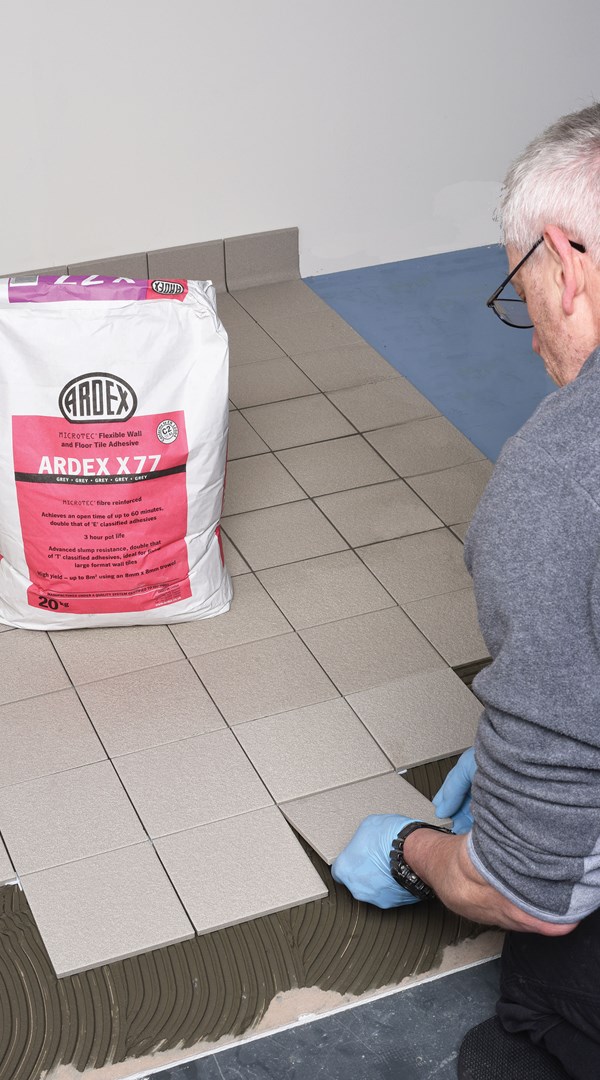You can read more about how we use cookies here.
Fixing, cleaning & maintenance
MOVEMENT JOINTS
For interior or exterior floor tile installations, movement joints should be located:
- over existing structural movement joints
- around the perimeter of the floor and where tiling abuts columns, curbs, steps and plant fixed to the base
- in large floor areas tiling should be divided into bays not exceeding 8-10m intervals. On suspended floors the bay size should be reduced and additional joints provided over supporting walls and beams
All floor tile joints should extend throughout the depth of the tile, bed and screed and should be 6-10mm in width.
They should be designed to avoid being subjected to the effect of wheeled traffic and where this is not possible metal reinforced joints should be specified.
Grout: highly pigmented grout may stain the tiles. Always test before installation.
We recommend SYSTEM ARDEX Premium Performance Screeds, Renders and Grouts to ensure a first quality installation.
AFTER FIXING
It is the responsibility of the owner to provide for routine inspection, appropriate maintenance, and to assure compatibility of all cleaning methods/ products with grout and mortar manufacturers. Appropriate maintenance requirements are determined by the site environment and the specific use of the installation. All damaging contaminants must be removed from grout joints sufficiently and regularly to avoid permanent damage from exposure to food, biological waste, industrial chemicals and aggressive cleaning solutions. Consult manufacturers for recommended procedures.
They should be designed to avoid being subjected to the effect of wheeled traffic and where this is not possible metal reinforced joints should be specified.
CLEANING
Newly Laid Floors
There may be residual cement on the tile surface of newly laid floors. All traces of this must be removed by applying a mildly acidic decementing solution, which must be rinsed off thoroughly. Clean regularly as specified below.
Regular Cleaning
Regular cleaning with warm water (or hot water for oil and grease) and a neutral or mildly alkaline (pH to 8) detergent will remove all but the most stubborn dirt. Mix the detergent as recommended by the manufacturer. The water/detergent mixture must be left on the floor for enough time (5-15 minutes) to allow it to penetrate and emulsify the dirt. Rinse thoroughly with clean water to remove all traces of the detergent mixture.
Large areas of plain or textured surface tiles are best cleaned with rotary, cylindrical or reversing mechanical scrubbing machines as follows:
- Use slow to medium speed rotation. If the machine has a suction drying facility, use it first with the suction facility switched OFF. This permits the water detergent mixture used in the scrubbing process to remain on the floor to penetrate the dirt layer.
- Leave for at least 5-15 minutes to elapse, then repeat the scrubbing operation with clean water only and with the suction drying facility switched ON. It is the rinsing process which removes the dirt.
- Spillages of oil, fat or any material likely to stain or cause a slipping hazard should be removed immediately by using detergent and hot water, followed by a cold water rinse.
- Use warning signs or physically exclude people from wet cleaning areas until they are completely dry.
Longer Term Maintenance
Clean the floor periodically using a rotary, cylindrical or reversing scrubbing machine with the addition of an abrasive powder or fine Silica Sand. These products scour the tiles, remove impacted dirt, and generally refresh the floor without damaging their surface. Remove the residue with clean water and rinse before it can dry out. If high velocity water jets are used for removal of stubborn dirt this will not damage the tiles, but may erode the joints if used regularly. If oil or grease is present, use the jet with warm or hot water and with a pH neutral detergent.
Please note that marks made during installation and with constant use may be more obvious on pale colours. Therefore even Dorset Woolliscroft fully vitrified tiles will require a certain amount of extra cleaning in areas prone to heavy soiling.
NB. These cleaning and maintenance instructions are Dorset Woolliscroft’s recommendations and not necessarily exhaustive. The recommendations of manufacturers of cleaning equipment and materials should always be followed.

We recommend SYSTEM ARDEX Premium
